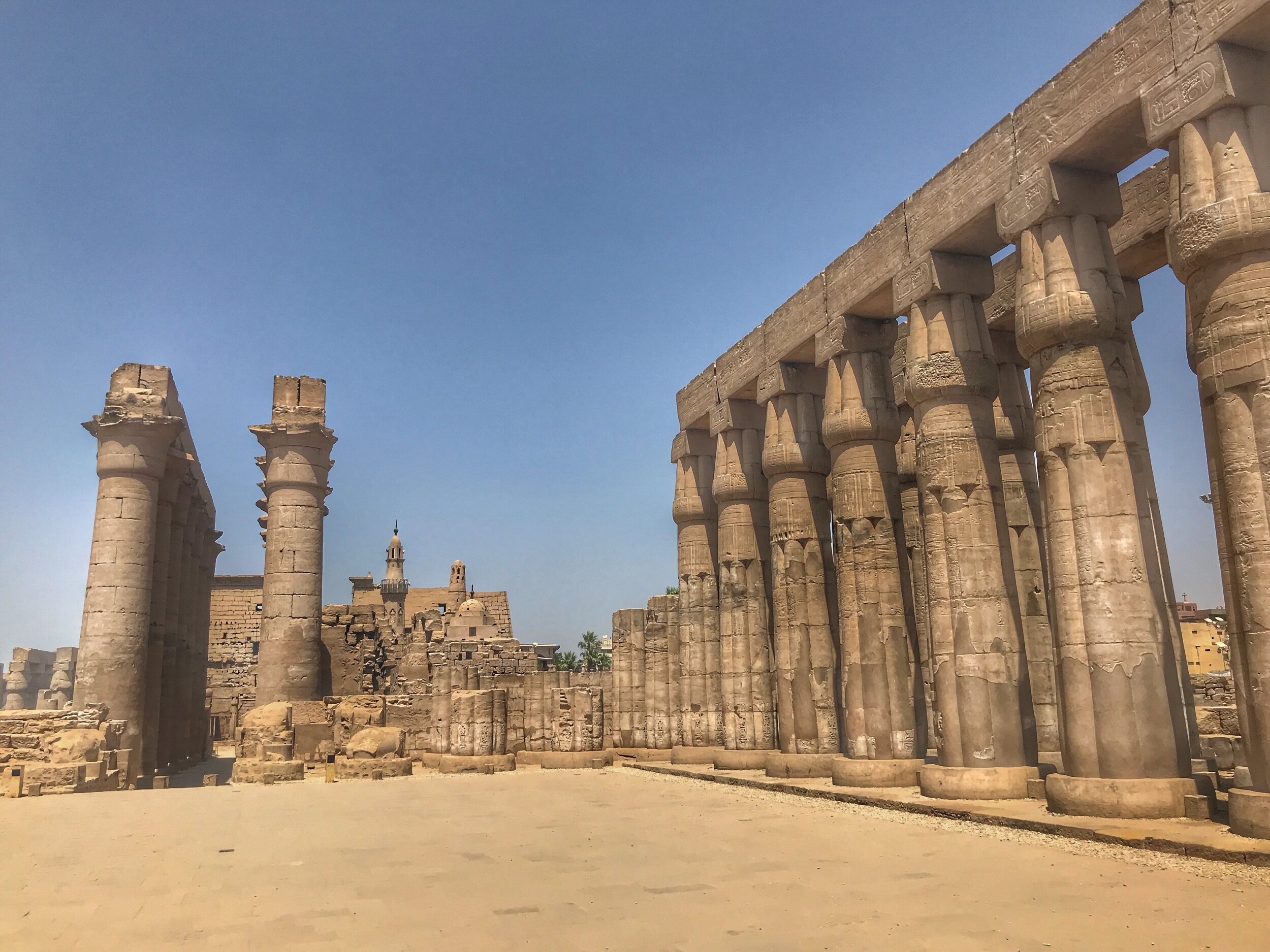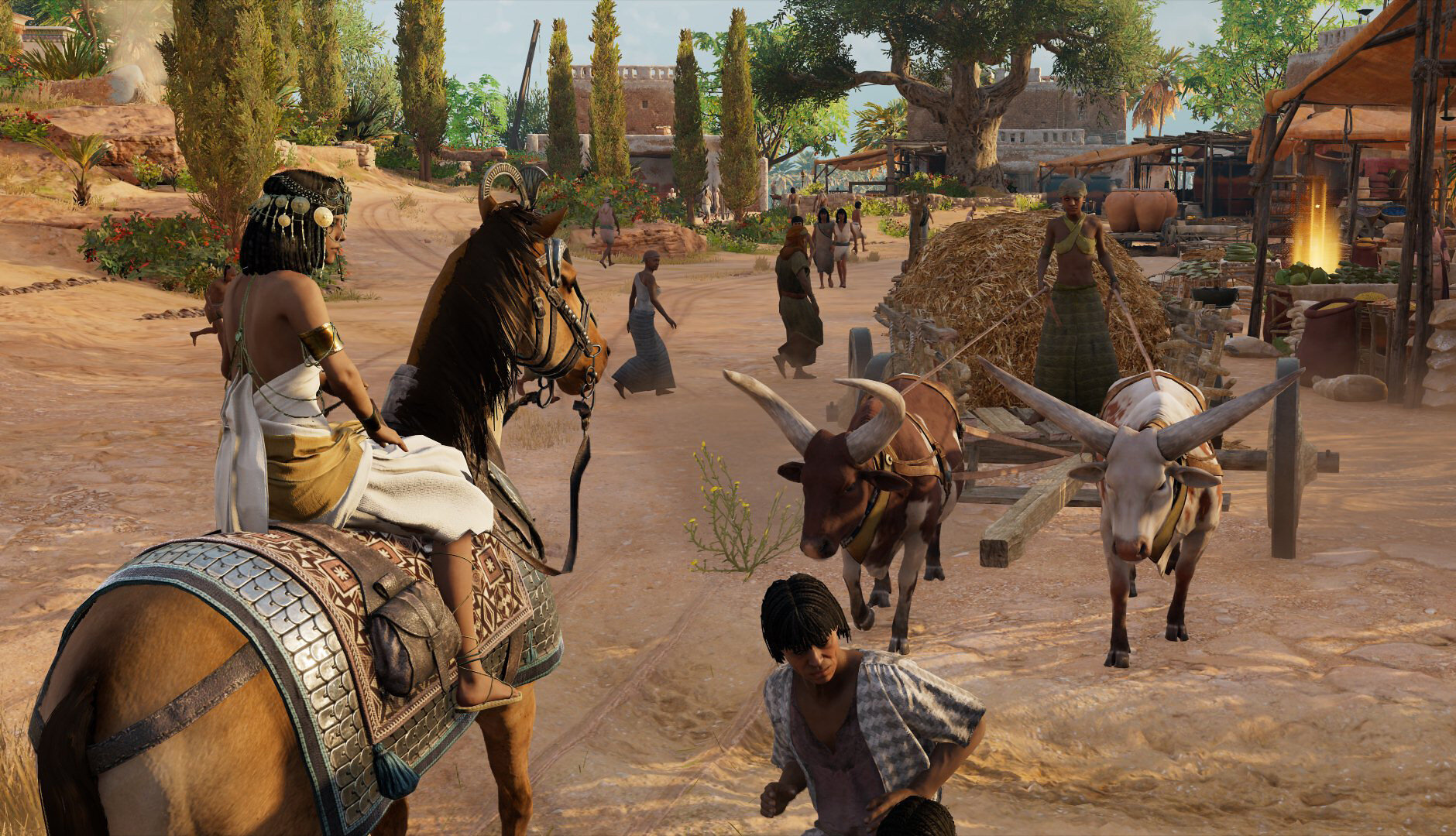The town of Luxor now surrounds this ancient complex built as a festival site by Amenhotep III and added on to by Hatshepsut, King Tut and Alexander the Great.
The modern city of Luxor has been built around the ancient temple complex
Americans never wanted a monarch like our friends across the pond, against whom we rebelled to set up a democracy. So we don’t know what it’s like to get caught up in a king’s or queen’s jubilee as the Brits do.
It was a similar type of celebration that led to Luxor Temple. Amenhotep III, having been on the throne for 30 years, was due a Sed festival, an ancient rite to represent the rejuvenation of the pharaoh and renew his contract with the gods. Not every pharaoh made it three decades on the throne — at a time when that was pretty much the life expectancy — and Amenhotep was determined to celebrate his jubilee unlike any of his forebears.
“Don’t miss the carvings of none other than Alexander the Great worshipping Amun-Min, whose massive hard-on points toward the legendary, bisexual conqueror.”
Luxor Temple was an important place of worship for 3,000 years!
He looked three miles south of Karnak Temple and directly across the Nile from his mortuary temple at a small shrine that acted as the “southern residence” of the composite god Amun-Ra. The town of Luxor, known as Thebes in ancient times, now surrounds the temple complex.
This colonnade was designed to resemble bundles of papyrus, an important plant for the Egyptians, used to make paper, sandals and other essentials
Amenhotep III had his architects design a vast open court with double rows of columns that resemble bundles of papyrus. The pharaoh was becoming more and more interested in solar worship, so he instructed that no roof cover this structure, allowing the sun’s rays to fill the space. With electrum walls and silver furnishings, you can only imagine how blinding the court would have been on a sunny day, filling worshippers with a sense of awe at the power of Amun-Ra.
Because they make noise at sunrise, as if in greeting, baboons were connected to sun worship for the Ancient Egyptians
Son of God
But Egyptologists say that the most important room in Luxor Temple is a small one at the back, behind the shrine where the solar barque, the god’s vessel, was kept, and next to an offering room. In this seemingly unobtrusive chamber, Amenhotep III rewrote his history (a favorite pastime of the pharaohs). He tells the tale of how his mother, Mutemwia, was visited in her bedchamber by what looked like her husband, Thutmose IV, but was actually the chief deity, Amun-Ra.
The inscription at Luxor is a much more graphic recounting than the divine parentage story Hatshepsut inscribed in her mortuary temple. Amenhotep seems to delight in the details of his mother’s arousal:
She awoke because of the god’s scent and cried out with pleasure before his majesty. … She rejoiced at the sight of his beauty, and love of him suffused her body. …
“How great is your power!” … Your dew permeates all my limbs.” And then the majesty of this god did all that he desired with her.
Amenhotep-ruler-of-Thebes is the name of this child that I have placed in your womb. … He shall exercise potent kingship in this entire land. … He shall rule the Two Lands like Ra forever.
Speaking of graphic depictions, the Amun worshipped here was conflated with the fertility god Min and was depicted with an impressive erection. Don’t miss the carvings here that show none other than Alexander the Great worshipping this god, whose massive hard-on points toward the legendary, bisexual conqueror.
Alexander the Great, crowned as pharaoh, worships Amun in the form of Min, who has one arm, one leg and one giant erection
Luxor Temple became the primary stage for kingly rituals, including the Opet festival, when the Amun statue at Karnak would come for a visit.
An avenue of sphinxes once stretched for two miles, connecting Luxor to Karnak Temple
Various pharaohs put their stamp on Luxor, as seen in the Court of Ramesses
A Favorite of the Pharaohs
Over the course of 3,000 years, pharaohs added onto or rebuilt the temple. It’s interesting that Amenhotep III is known as the Sun King, and that his son, Amenhotep IV, later chose the name of Akhenaten when he infamously shifted worship away from the pantheon led by Amun to a single deity, Aten, the sun itself. It seems the son took the father’s solar passion to an extreme.
While Amenhotep laid the foundation for a colonnade in front of his sun court, it was completed by Akhenaten’s short-lived son, the famous Tutankhamun. Inside the massive hall, columns soar 60 feet into the air, and six striding colossi wowed visitors.
Unlike so many other temples of Ancient Egypt, Luxor is open-aired, highlighting its connection to the sun
Ramesses II, who never shied away from an opportunity to proclaim his greatness, added on to Luxor, installing a forecourt, a pylon gateway and statues out front. To obtain the construction materials needed, he engaged in another preferred pastime of the pharaohs: razing and raiding the temples and pyramids of ages past.
Ramesses shifted the axis of the temple to the east to align it with Karnak, to which it was connected by a sphinx-lined processional avenue.
You can see where the ancient stone wall ends and the new mosque built atop it starts
Religions Built Atop One Another
Luxor, like most of the temples of Ancient Egypt was at some point buried in the shifting sands of the desert. But at no sight is this more clear than here, where you can literally see the different colors of the rock showing what was buried for millennia.
Old meets new and Islam meets Ancient Egyptian at Luxor
You can also see how the complex was converted to various Christian churches in the 4th to 6th centuries, when Romans incorporated the entire complex into a castrum, or fortified military encampment. Icons of various holy figures can still be seen painted on one of the walls.
In the late 3rd century, during the reign of Diocletian, this section of Luxor became a Roman legionary shrine. Part of the fresco can still be seen
With the rise of Islam, Muslims built a mosque atop one of the churches here. This striking place of worship sits perched atop one of Luxor’s surrounding walls and is still in use to this day.
Venture to the back of Luxor Temple to see statues of King Tut and Queen Ankhesenpaaten
A Bizarre Ritual Out Back
While we wandered the open-air structures at the back of the temple, past two pairs of decaying statues, an Egyptian policeman approached us. The ubiquitous machine gun strapped across his chest that never failed to put me ill at ease was counteracted by his beaming smile.
He signaled for us to follow him. A bit nervous but curious, Duke and I followed him into a nook in the far corner of the complex. The policeman gestured for our phone to take a picture. With Duke’s iPhone in hand, he began a series of strange choreography, intertwining our fingers of one hand and having us touch the ancient stone with the other. (I know you’re not supposed to touch the monuments, but when an armed guard tells you to do something, you obey. Sure enough, we weren’t the first to follow this bizarre ritual — the stone was worn, polished by the oils of countless hands.) He snapped a shot, then had us hold our hands toward each other in a prayer gesture, like we were about to play pattycake. Snap, another picture. And finally, he had us keep our hands in that position but place them against the wall in the same spot we had previously touched.
An armed policeman ran Duke and Wally through a series of strange motions — though they have no idea what it all meant
It was all quite amusing, though we’re not sure what exactly was the desired outcome. Perhaps it was an ancient spell for fertility — and if that’s the case, what a waste doing it on a couple of gays.
We offered the cop a tip, known as baksheesh in Arabic, which he gladly pocketed.
Admission to Luxor Temple costs 140 Egyptian pounds, or less than $9 at the time of this writing. –Wally











































